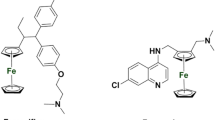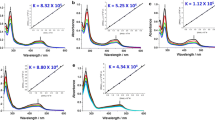Abstract
Reaction of salicylaldehyde-2-picolinylhydrazone (HL) Schiff base ligand with precursor compounds [{(p-cymene)RuCl2}2] 1, [{(C6H6)RuCl2}2] 2, [{Cp*RhCl2}2] 3 and [{Cp*IrCl2}2] 4 yielded the corresponding neutral mononuclear compounds 5–8, respectively. The in vitro antitumor evaluation of the compounds 1–8 against Dalton’s ascites lymphoma (DL) cells by fluorescence-based apoptosis study and by their half-maximal inhibitory concentration (IC50) values revealed the high antitumor activity of compounds 3, 4, 5 and 6. Compounds 1–8 render comparatively lower apoptotic effect than that of cisplatin on model non-tumor cells, i.e., peripheral blood mononuclear cells (PBMC). The antibacterial evaluation of compounds 5–8 by agar well-diffusion method revealed that compound 6 is significantly effective against all the eight bacterial species considered with zone of inhibition up to 35 mm. Fluorescence imaging study of compounds 5–8 with plasmid circular DNA (pcDNA) and HeLa RNA demonstrated their fluorescence imaging property upon binding with nucleic acids. The docking study with some key enzymes associated with the propagation of cancer such as ribonucleotide reductase, thymidylate synthase, thymidylate phosphorylase and topoisomerase II revealed strong interactions between proteins and compounds 5–8. Conformational analysis by density functional theory (DFT) study has corroborated our experimental observation of the N, N binding mode of ligand. Compounds 5–8 exhibited a HOMO (highest occupied molecular orbital)–LUMO (lowest unoccupied molecular orbital) energy gap 2.99–3.04 eV.
Graphical Abstract
Half-sandwich ruthenium, rhodium and iridium compounds were obtained by treatment of metal precursors with salicylaldehyde-2-picolinylhydrazone (HL) by in situ metal-mediated deprotonation of the ligand. Compounds under investigation have shown potential antitumor, antibacterial and fluorescence imaging properties. Arene ruthenium compounds exhibited higher activity compared to that of Cp*Rh/Cp*Ir in inhibiting the cancer cells growth and pathogenic bacteria. At a concentration 100 µg/mL, the apoptosis activity of arene ruthenium compounds, 5 and 6 (~30 %) is double to that of Cp*Rh/Cp*Ir compounds, 7 and 8 (~12 %). Among the four new compounds 5–8, the benzene ruthenium compound, i.e., compound 6 is significantly effective against the pathogenic bacteria under investigation.












Similar content being viewed by others
Abbreviations
- AO:
-
Acridine orange
- DFT:
-
Density functional theory
- DL:
-
Dalton’s ascites lymphoma
- DMSO:
-
Dimethyl sulfoxide
- EtBr:
-
Ethidium bromide
- FBS:
-
Fetal serum albumin
- HOMO:
-
Highest occupied molecular orbital
- LUMO:
-
Lowest unoccupied molecular orbital
- PBS:
-
Phosphate-buffered saline
- pcDNA:
-
Plasmid circular DNA
- RPMI:
-
Roswell park memorial institute medium
- TAE:
-
Tris-acetate EDTA
- TDDFT:
-
Time-dependant density functional theory
References
Jamieson ER, Lippard SJ (1999) Chem Rev 99:2467–2498
Siddik ZH (2003) Oncogene 22:7265–7279
Thompson CB (1995) Science 267:1456–1462
Dorr RT, Pinedo HM, Schornagel JH (1996) Platinum and other metal coordination compounds in cancer chemotherapy. Plenum, New York, p 131
Clarke MJ (1980) Met Ions Biol Syst 1:231–283
Lin GJ, Jiang GB, Xie YY, Huang HL, Liang ZH, Liu YJ (2013) J Biol Inorg Chem 18:873–882
Han BJ, Jiang GB, Wang J, Li W, Huang HL, Liu YJ (2014) RSC Adv 4:40899–40906
Jiang GB, Yao JH, Wang J, Li W, Han BJ, Lin GJ, Xie YY, Huang HL, Liu YJ (2014) New J Chem 38:2554–2563
Bergamo A, Sava G (2011) Dalton Trans 40:7817–7823
Timerbaev AR, Hartinger CG, Aleksenko SS, Keppler BK (2006) Chem Rev 106:2224–2248
Kandioller W, Balsano E, Meier SM, Jungwirth U, Göschl S, Roller A, Jakupec MA, Berger W, Keppler BK, Hartinger CG (2013) Chem Commun 49:3348–3350
Liu Z, Salassa L, Habtemariam A, Pizarro AM, Clarkson GJ, Sadler PJ (2011) Inorg Chem 50:5777–5783
Lucas SJ, Lord RM, Wilson RL, Phillips RM, Sridharan V, McGowan PC (2012) Dalton Trans 41:13800–13802
Prescott LM, Harley JP, Klein DA (1990) Microbiology, 2nd edn. WMC, Brown publishers, Oxford, p 328
Goldie H, Felix MD (1951) Cancer Res 11:73–80
Gajendra G, Sharma G, Biplob K, Sunhong P, Lee SS, Kim JW (2013) New J Chem 37:2573–2581
Jagessar RC, Gomathinayagam S (2012) JPCS 4:1–6
Lo KKW, Choi AW, Law WH (2012) Dalton Trans 41:6021–6047
Lo KKW, Lee TKM, Zhang KY (2006) Inorg Chim Acta 359:1845–1854
Leung SK, Wok KY, Zhang KY, Lo KKW (2010) Inorg Chem 49:4984–4995
Ulbricht C, Beyer B, Friebe C, Winter A, Schubert US (2009) Adv Mater 21:4418–4441
Lo KKW, Chung CK, Zhu N (2006) Chem Eur J 12:1500–1512
Lo KKW, Zhang KY, Chung CK, Wok KY (2007) Chem Eur J 13:7110–7120
Zhang KY, Li SPY, Zhu N, Or IWS, Cheung MSH (2010) Inorg Chem 49:2530–2540
Wu H, Yang T, Zhao Q, Zhou J, Li C (2011) Dalton Trans 40:1969–1976
Tan W, Zhou J, Li F, Yi T, Tian H (2011) Chem Asian J 6:1263–1268
Vueba ML, Pina ME, Batista LAE, Carvalho DJ (2008) Pharm Sci 97:845–849
Grove H, Kelly TL, Thompson K, Zhao L, Xu Z, Abedin TSM, Miller DO, Goeta AE, Wilson C, Howard JAK (2004) Inorg Chem 43:4278–4288
Salassa L, Garino C, Albertino A, Volpi G, Nervi C, Gobetto R, Hardcastle KI (2008) Organometallics 27:1427–1435
Garino C, Ruiu T, Salassa L, Albertino A, Volpi G, Nervi C, Gobetto R, Hardcastle KI (2008) Eur J Inorg Chem 36:3587–3591
Garino C, Gobetto R, Nervi C, Salassa V, Rosenberg E, Ross JBA, Chu X, Hardcastle KI, Sabatini C (2007) Inorg Chem 46:8752–8762
Albertino A, Garino C, Ghiani S, Gobetto R, Nervi C, Salassa L, Rosenberg E, Sharmin A, Viscardi G, Buscaino R, Croce G, Milanesio M (2007) J Organomet Chem 692:1377–1391
Angelis FD, Car R, Spiro TG (2003) J Am Chem Soc 125:15710–15711
Salassa L, Garino C, Salassa G, Gobetto R, Nervi C (2008) J Am Chem Soc 130:9590–9597
Salassa L, Garino C, Salassa G, Nervi C, Gobetto R, Lamberti C, Gianolio D, Bizzarri R, Sadler PJ (2009) Inorg Chem 48:1469–1481
Funaki T, Funakoshi H, Kitao O, Komatsuzaki NO, Kasuga K, Sayama K, Sugihara H (2012) Angew Chem Int Ed 51:7528–7531
Perrin DD, Armarego WLF (1996) Purification of laboratory chemicals, 4th edn. Butterworths-Heinemann, London, p 416
Bennet MA, Huang TN, Matheson TW, Smith AK, Robertson GB (1982) Inorg Synth 21:74
White C, Yates A, Maitlis PM (1992) Inorg Synth 29:228
Bai Y, Dang D, Cao X, Duan C, Meng Q (2006) Inorg Chem Commun 9:86–89
(2004) Stoe & Cie, X–RED, version 1.28b, Program for data reduction and absorption correction. Stoe & Cie GmbH, Darmstadt, Germany
Sheldrick GM (1997) SHELXL. University of Gottingen, Germany
Farrugia LJ (1997) J Appl Cryst 30:565–566
Bruno IJ, Cole JC, Edgington PR, Macrae CF, Pearson J, McCabe P, Taylor R (2002) Acta Crystallogr B 58:389–397
Meech SR, Phillips DJ (1983) Photochem 23:193–217
Mataga N, Kubota T (1970) In molecular interactions and electronic spectra. Marcel Dekker Inc., New York
Prasad SB, Verma AK (2013) Microsc Microanal 19:1–18
Takayama T, Sekine T, Makuuchi M, Yamasaki S, Kosuge T, Yamamoto J, Shimada K, Sakamoto M, Hirohashi S, Ohashi Y, Kakizoe T (2000) Lancet 356:802–807
Perez C, Paul M, Bazerque P (1990) Acta Bio Med Exp 15:113–115
Becke AD (1993) J Chem Phys 98:5648–5652
Becke AD (1988) Phys Rev A 38:3098–3100
Becke AD (1988) J Chem Phys 88:2547–2553
Frisch MJ, Trucks GW, Schlegel HB, Scuseria GE, Robb MA, Cheeseman JR, Scalmani G, Barone V, Mennucci B, Petersson GA, Nakatsuji H, Caricato M, Li X, Hratchian HP, Izmaylov AZ, Bloino J, Zheng G (2010) GAUSSIAN 09 (Revision B. 01). Gaussian, Inc., Wallingford
Boyle NMO, Tenderholt AL, Langner KM (2008) J Comput Chem 29:839
Thomsen R, Christensen MH (2006) J Med Chem 49:3315–3321
Verma AK, Prasad SB (2013) Anticancer Agents in Med Chem 13:1096–1114
Singh KS, Caroll PJ, Rao KM (2005) Polyhedron 24:391–396
Govindaswamy P, Canivet J, Suss-Fink G, Stepnicka P, Ludvik J, Rao KM (2007) J Organomet Chem 692:3664–3675
Prasad K, Therrien B, Rao KM (2008) J Organomet Chem 693:3049–3059
Prasad KT, Gupta G, Rao AV, Das B, Rao KM (2009) Polyhedron 28:2649–2654
Habtemariam A, Melchart M, Fernández R, Rarsons S, Oswald V, Parkin A, Fabbiani FPA, Davidson JE, Dawson A, Aird RE, Jodrell DI, Sadler PJ (2006) J Med Chem 49:6858–6868
Liu J, Lu TB, Deng H, Ji LN, Qu LH, Zhou H (2003) Trans Metal Chem 28:116–121
Singh P, Bhardwaj A (2008) Rev Med Chem 8:388–398
Basu Baul TS, Paul A, Pellerito L, Scopelliti M, Singh P, Verma P, Duthie A, de Vos D, Tiekink ER (2011) Invest New Drugs 29:285–299
Nongbri SL, Das B, Rao KM (2012) J Chem Sci 124:1365–1375
Acknowledgments
K. M. Rao gratefully acknowledges financial support from the CSIR, New Delhi, through the Research Grants No. 01(2493)/11/EMR-II. P. N. Rao thanks UGC, New Delhi for providing fellowship in the form of JRF and SRF. We thank SAIF and DST-PURSE SCXRD of NEHU for collecting NMR and X-ray analysis data. We thank Dr. G. Narahari Sastry, IICT, Hyderabad, for providing facility to carry out DFT calculations, Mr. Veeranjaneylulu, IISc Bangalore for his support in various analyses, Dr. S. Mitra and Mr. Mullahmuhai for their help in fluorescence studies.
Author information
Authors and Affiliations
Corresponding author
Electronic supplementary material
Below is the link to the electronic supplementary material.
775_2015_1249_MOESM1_ESM.pdf
CCDC 1036511 [6], CCDC 1012445 [7] and 1012446 [8] contain the supplementary crystallographic data for this paper. These data can be obtained free of charge via http://www.ccdc.cam.ac.uk/data_request/cif, by e-mailing data_request@ccdc.cam.ac.uk, or by contacting The Cambridge Crystallographic Data Centre, 12, Union Road, Cambridge CB2 1EZ, UK; fax: +44 1223 336033 (PDF 1001 kb)
Rights and permissions
About this article
Cite this article
Palepu, N.R., Nongbri, S.L., Premkumar, J.R. et al. Synthesis and evaluation of new salicylaldehyde-2-picolinylhydrazone Schiff base compounds of Ru(II), Rh(III) and Ir(III) as in vitro antitumor, antibacterial and fluorescence imaging agents. J Biol Inorg Chem 20, 619–638 (2015). https://doi.org/10.1007/s00775-015-1249-3
Received:
Accepted:
Published:
Issue Date:
DOI: https://doi.org/10.1007/s00775-015-1249-3




